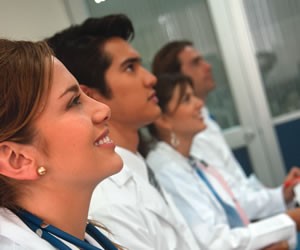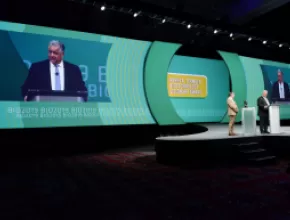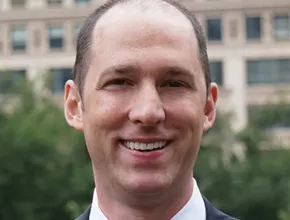With medical meetings one of the industry’s most prized market segments, it’s not surprising that CVBs are trying their hardest to attract as many of them as possible. The reason for their interest is simple: No matter what economic forces are at play, medical meetings still live on.
Doctors are always in need of CME (continuing medical education) credits, hospital administrators are forever seeking training for new versions of their software systems, and countless medical associations are constantly looking for places to meet.
Going Local
Increasingly, CVBs are courting the medical meetings segment by partnering with local health care resources. This is especially the case for cities fortunate enough to have name-brand medical facilities located at their backdoor.
Rochester, Minn., is one such location—for at its backdoor is none other than the world-renowned Mayo Clinic.
"We are very lucky because we have Mayo Clinic right here," says Brad Jones, executive director of the Rochester CVB. "We simply try to allow ourselves to be a go-between between a meeting planner and them. We try to tap into speakers and research projects that would tie into the event or meeting."
Jones says about 30 percent to 35 percent of the city’s convention business comes from the medical segment, but "if you look at total visitors to the city, it is 70 percent of our business. We welcome about 2.5 million visitors per year, so 70 percent is a big number."
Another city with a healthy dose of medical resources is Cleveland, site of the Cleveland Clinic. Stephanie Stiggers-Smith, national sales manager for Positively Cleveland, says the CVB often partners with the clinic to bring in meetings.
"We usually have them support us in our advocacy to bring meetings here," she says, adding that it is common for medical professionals from Cleveland Clinic to meet with meeting planners to attract them to the city. "It helps us to sell meetings."
For Houston, a major draw is the Texas Medical Center, which "represents 47 different medical entities and 14 are hospitals," says Ken Middleton, vice president of convention sales for the Greater Houston CVB, who adds that the city’s focus has expanded beyond the traditional oil market.
"For so many years it was oil and ‘what are you doing with the Gulf.’ Now we have an outstanding vertical beyond the energy conversation," he says, adding that "17 percent of our overall booking is from medical meetings. That is over 7,000 room nights."
With an important local resource like the Texas Medical Center, Middleton says planners don’t have to fly speakers in from all over the world; they can find them in Houston—along with research specialists.
"If a conference is here, chances are there are people who wrote white papers on what you are looking for that live in Houston," he says.
In San Francisco, where important local resources include UCSF Medical Center, the health care meetings segment makes up a staggering portion of the city’s business.
"I’d say about 60 percent of our business at Moscone is medical meetings," says Lysa Lewin, managing director of convention sales for the San Francisco CVB. "We are just very fortunate to have a city that people want to come to."
Two CVBs in a medical meeting league of their own are the Philadelphia CVB and the Orlando CVB. Each city has zeroed in on the market segment in a big way.
In Philadelphia, the medical market has always been a staple, owing to several life science organizations, medical equipment and biotech start-ups and almost 100 colleges and universities within a short drive. However, it wasn’t until 2005, when the city hosted a huge medical convention drawing 18,000 delegates, that the CVB decided to change its structure to attract more health care groups.
While preparing for the event, the CVB formed a steering committee specifically for the convention consisting of locals in the medical field as well as tourism officials. The convention was such a success that the CVB decided to morph the steering committee into the Greater Philadelphia Life Sciences Congress.
"We have 60 regional leaders on the board and many are on boards of medical associations," says Bonnie Grant, executive director of the Greater Philadelphia Life Sciences Congress, a division of the Philadelphia CVB, adding that board members get personally involved in attracting meetings to the city.
"They write letters of support," she says. "They lobby for Philadelphia as a destination and they also support us in the sales process. They will even speak to planners in the pre-planning process."
Once a meeting is secured, the Congress enlists its members to help book relevant speakers and will make introductions for sponsorships, according to Grant.
"It makes sense to bring a meeting where the business is, as opposed to a resort or something like that," she says.
In Orlando, the CVB recently formed a medical advisory board, "specifically targeting the medical market," says Gary Sain, president and CEO of the Orlando/Orange County CVB. "The board is made up of about 15 to 20 meeting professionals that are helping us to shape the future—the future of medical meetings."
According to Sain, the CVB is now working as a marketing partner and consultant to medical meeting planners.
"We are not only booking space, we are helping them with speakers, branding and attendance," he says.
High Expectations
Medical meetings are widely understood to have their own unique characteristics and requirements. For starters, those who attend are looking for an exemplary product.
"The medical attendee is different than most," says Houston’s Middleton. "They want high-end. They expect a service delivery that is higher than most."
Several cities are making large-scale changes to accommodate demands.
One is Rochester, where "in the next six months we are expanding the convention center to add all upscale and high-end convention space," says the CVB’s Jones. "We will have the largest ballroom in the state of Minnesota after this is done [in June 2012]."
"This project was born from listening and adapting to the medical marketplace," Jones says. "We are going to invest $75 million to $100 million to address that marketplace and the changing atmosphere of it."
Big plans are also under way in Cleveland, where the bureau is working with Merchandise Mart Properties Inc. to create a medical mart.
"Plans are under way to have a new convention center with a medical mart attached," says Samantha Fryberger, spokesperson for Positively Cleveland. "By 2013, early 2014, we hope to have a new convention center on the site of the current convention center."
Orlando is kicking it up a notch by building a "medical city," a 10-year project on the east side of the region’s airport.
Construction on the Lake None Medical City is under way with a few facilities already opened, such as a University of Central Florida medical school and the Burnham Institute for Medical Research, according to the CVB’s Sain.
"We are going to have world-class medical professionals moving to Orlando," Sain says. "It is going to change the brand."
Katie Morell, a former editor at Meetings Media, is a freelance writer based in Chicago.





